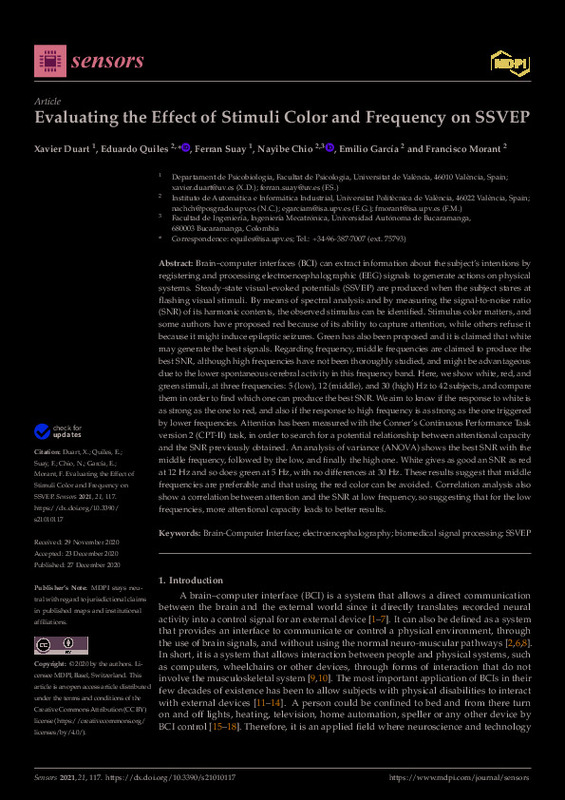JavaScript is disabled for your browser. Some features of this site may not work without it.
Buscar en RiuNet
Listar
Mi cuenta
Estadísticas
Ayuda RiuNet
Admin. UPV
Evaluating the Effect of Stimuli Color and Frequency on SSVEP
Mostrar el registro sencillo del ítem
Ficheros en el ítem
| dc.contributor.author | Duart, Xavier
|
es_ES |
| dc.contributor.author | Quiles Cucarella, Eduardo
|
es_ES |
| dc.contributor.author | Suay, Ferran
|
es_ES |
| dc.contributor.author | Chio, Nayibe
|
es_ES |
| dc.contributor.author | García Moreno, Emilio
|
es_ES |
| dc.contributor.author | Morant Anglada, Francisco José
|
es_ES |
| dc.date.accessioned | 2024-02-15T19:01:38Z | |
| dc.date.available | 2024-02-15T19:01:38Z | |
| dc.date.issued | 2021-01 | es_ES |
| dc.identifier.uri | http://hdl.handle.net/10251/202677 | |
| dc.description.abstract | [EN] Brain-computer interfaces (BCI) can extract information about the subject's intentions by registering and processing electroencephalographic (EEG) signals to generate actions on physical systems. Steady-state visual-evoked potentials (SSVEP) are produced when the subject stares at flashing visual stimuli. By means of spectral analysis and by measuring the signal-to-noise ratio (SNR) of its harmonic contents, the observed stimulus can be identified. Stimulus color matters, and some authors have proposed red because of its ability to capture attention, while others refuse it because it might induce epileptic seizures. Green has also been proposed and it is claimed that white may generate the best signals. Regarding frequency, middle frequencies are claimed to produce the best SNR, although high frequencies have not been thoroughly studied, and might be advantageous due to the lower spontaneous cerebral activity in this frequency band. Here, we show white, red, and green stimuli, at three frequencies: 5 (low), 12 (middle), and 30 (high) Hz to 42 subjects, and compare them in order to find which one can produce the best SNR. We aim to know if the response to white is as strong as the one to red, and also if the response to high frequency is as strong as the one triggered by lower frequencies. Attention has been measured with the Conner's Continuous Performance Task version 2 (CPT-II) task, in order to search for a potential relationship between attentional capacity and the SNR previously obtained. An analysis of variance (ANOVA) shows the best SNR with the middle frequency, followed by the low, and finally the high one. White gives as good an SNR as red at 12 Hz and so does green at 5 Hz, with no differences at 30 Hz. These results suggest that middle frequencies are preferable and that using the red color can be avoided. Correlation analysis also show a correlation between attention and the SNR at low frequency, so suggesting that for the low frequencies, more attentional capacity leads to better results. | es_ES |
| dc.language | Inglés | es_ES |
| dc.publisher | MDPI AG | es_ES |
| dc.relation.ispartof | Sensors | es_ES |
| dc.rights | Reconocimiento (by) | es_ES |
| dc.subject | Brain-Computer Interface | es_ES |
| dc.subject | Electroencephalography | es_ES |
| dc.subject | Biomedical signal processing | es_ES |
| dc.subject | SSVEP | es_ES |
| dc.subject.classification | INGENIERIA DE SISTEMAS Y AUTOMATICA | es_ES |
| dc.title | Evaluating the Effect of Stimuli Color and Frequency on SSVEP | es_ES |
| dc.type | Artículo | es_ES |
| dc.identifier.doi | 10.3390/s21010117 | es_ES |
| dc.rights.accessRights | Abierto | es_ES |
| dc.contributor.affiliation | Universitat Politècnica de València. Escuela Técnica Superior de Ingenieros Industriales - Escola Tècnica Superior d'Enginyers Industrials | es_ES |
| dc.contributor.affiliation | Universitat Politècnica de València. Escuela Técnica Superior de Ingeniería del Diseño - Escola Tècnica Superior d'Enginyeria del Disseny | es_ES |
| dc.description.bibliographicCitation | Duart, X.; Quiles Cucarella, E.; Suay, F.; Chio, N.; García Moreno, E.; Morant Anglada, FJ. (2021). Evaluating the Effect of Stimuli Color and Frequency on SSVEP. Sensors. 21(1). https://doi.org/10.3390/s21010117 | es_ES |
| dc.description.accrualMethod | S | es_ES |
| dc.relation.publisherversion | https://doi.org/10.3390/s21010117 | es_ES |
| dc.type.version | info:eu-repo/semantics/publishedVersion | es_ES |
| dc.description.volume | 21 | es_ES |
| dc.description.issue | 1 | es_ES |
| dc.identifier.eissn | 1424-8220 | es_ES |
| dc.identifier.pmid | 33375441 | es_ES |
| dc.identifier.pmcid | PMC7796402 | es_ES |
| dc.relation.pasarela | S\424616 | es_ES |
| dc.subject.ods | 03.- Garantizar una vida saludable y promover el bienestar para todos y todas en todas las edades | es_ES |








